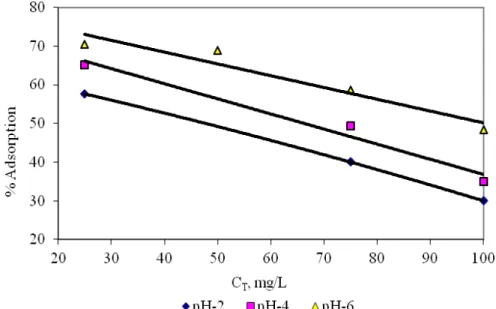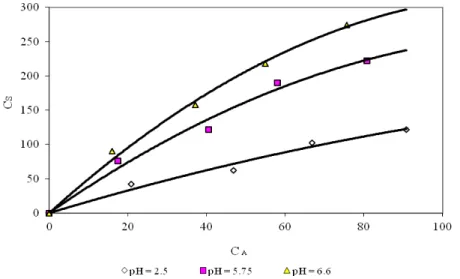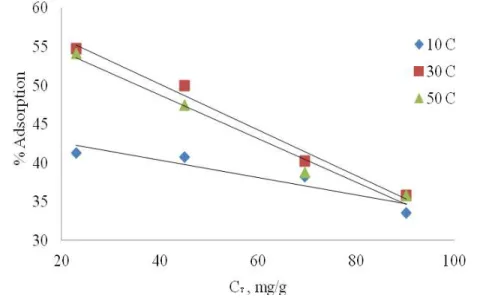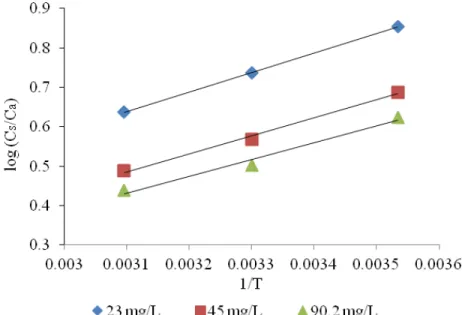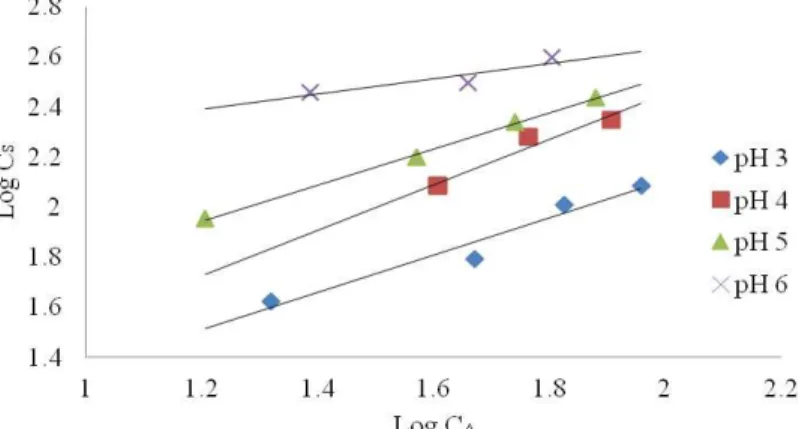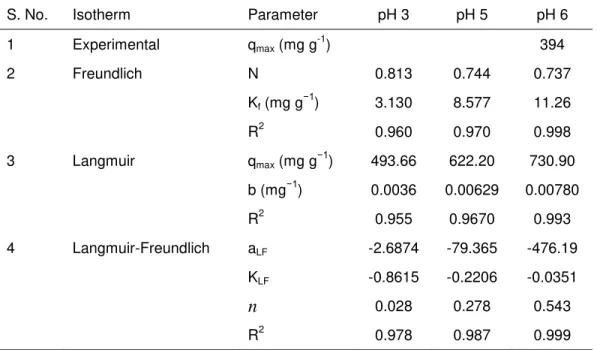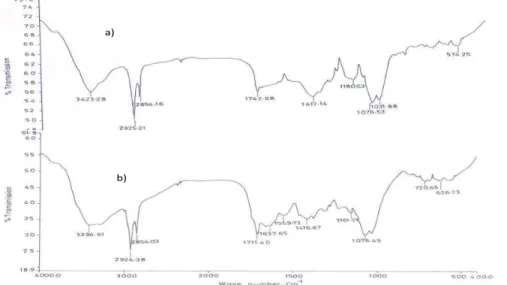PEER-REVIEWED ARTICLE
bioresources.
com
STUDIES ON BIOSORPTION OF NICKEL USING IMMOBILIZED
FUNGUS,
RHIZOMUCOR TAURICUS
K. Kishore Kumar,*a M. Krishna Prasad,b B. Sarada,c and Ch. V. R. Murthy a Rhizomucor tauricus, an industrial fungus, was immobilized in sodium
alginate and used as adsorbent for the removal of nickel from aqueous solutions. The biosorption capacity of Ni(II) was found to be 394 mg/g of immobilized biomass. It was observed that an increase in pH from 3 to 6 increased the percent adsorption, and an increase in liquid-to-solid ratio from 2 to 10 increased the metal uptake. The percent adsorption was increased when increasing the initial metal concentration from 25 to 100 mg/L. The equilibrium biosorption data was evaluated by Langmuir, Freundlich, and Langmuir-Freundlich (L-R) isotherm models, and was best described by the Langmuir and Freundlich isotherms. FTIR analysis revealed that –NH (bending), C–H (stretching), C=O (stretching), and – OH functional groups were mainly responsible for Ni(II) biosorption. Thus, this study demonstrated that the immobilized Rhizomucor tauricus
biomass could be used as an adsorbent for the treatment of Ni(II) from aqueous solution.
Keywords: Rhizomucor tauricus; Fungus; Immobilization; Isotherms; FTIR
Contact information: a: Department of Chemical Engineering, College of Engineering, Andhra University, Visakhapatnam, Andhra Pradesh, India 530 003; b: Department of Chemical Engineering, GMR Institute of Technology, GMR Nagar, Rajam, Andhra Pradesh, India 532 127; c: Department of Biotechnology, GITAM University, Visakhapatnam, Andhra Pradesh, India 530 045.
* Corresponding author: drkadimpatikks@gmail.com
INTRODUCTION
Water pollution by heavy metals is very toxic in nature and eventually accumu-lates throughout the food chain, causing serious threat to mankind. These toxic metals can cause accumulation poisoning, cancer, brain damage, and renal malfunctioning when found above the tolerance limit. Pollution by nickel is of considerable concern because the metal has found widespread use in electroplating, metal finishing, etc. The presence of Ni(II) ions above critical levels may cause various types of acute and chronic disorder in human health, such as severe damage of lungs and kidney, gastrointestinal distress (e.g. nausea, vomiting, and diarrhea), pulmonary fibrosis, renal edema, and skin dermatitis. The toxic limit of Ni(II) as insoluble compounds of Ni is 1 mgm−3, soluble compounds of Ni 0.1 mgm−3, nickel carbonyl of 0.05 to 0.12 mgm−3, and nickel sulphide of 1 mgm−3 (Lothongkum et al. 2009; Pahlavanzadeh et al. 2010).
Biosorption refers to metal sequestration by biomass through adsorption, ion-exchange, coordination, complexation, etc. Application of fungal biomass to remove heavy metals from industrial wastewater is economically valuable, technically sound, socially acceptable, and is attractive for industry. Many fungal species, such as
PEER-REVIEWED ARTICLE
bioresources.
com
Saccharomyces cerevisiae (Lin et al. 2005), Mucor hiemalis (Tewari et al. 2005),
Botrytis cinerea (Akar and Tunali 2005), Neurospora crassa (Tunali et al. 2005),
Lentinus sajor-caju (Bayramoglu et al. 2005), and Phanerochaete chrysosporium (Iqbal and Asma 2007) have been extensively studied for heavy metal biosorption.
Natural polymers such as alginate, chitosan, chitin, and cellulose derivatives have been used as the matrix for the immobilization of microbial cells via an entrapment technique. A major advantage of alginate gel entrapment is that immobilized cells do not suffer extreme physical-chemical condition changes during the immobilization process. Permeability, null toxicity, and transparency of the formed matrix imply a very gentle environment for immobilized cells (Smidsrød and Skjåk-Braek 1990; Kumar et al. 2006).
Immobilized fungal cells have been found to be far more stable during experimentation in the batch system than the free fungal cells. Several researchers reported immobilized fungal biomass for biosorption of heavy metal ions, using calcium alginate, such as Trametes versicolor (Bayramoglu et al. 2003), Rhizopus arrhizus (Liao
et al. 2004), Tetraselmis chuii (Moreno-Garrido et al. 2005), and Rhizomucor tauricus
(Kumar et al. 2009).
Some of the workers used dead fungal biomass, eliminating the need for nutrient use. Fungal biomass varieties can also be used as biosorbents, such as Botrytis cinerea
(Akar and Tunali 2005), Mucor hiemalis (Tewari et al. 2005), and S. cerevisiae (Lin et al.
2005; Murthy et al. 2007). The -COOH, -NH2, -OH, and -SH groups on microbial cell
walls provide the binding sites for interaction of metal ions (Kuyucak and Volesky 1998).
Rhizomucor tauricus was chosen as biosorbent material because it is a waste industrial fungus that removes Ni(II) ions from aqueous solution.
EXPERIMENTAL
Materials
Immobilization of Rhizomucor tauricus
The fungus Rhizomucor tauricus MTCC 1976 was purchased from MTCC, Chandigarh. R. tauricus was produced by standard culture technique using potato dextrose broth and incubated for 72 hours at 30 °C. The biomass was filtered through a vacuum filtration unit to separate the unused nutrient broth. It was rinsed twice, filtered through the vacuum filtration unit, and resuspended in distilled water. Sodium alginate (4%) solution was prepared in hot distilled water at room temperature.
PEER-REVIEWED ARTICLE
bioresources.
com
Methods
Biosorption experiments
The primary stock solution was prepared with approximately 2000 ppm of Ni(II) in solution. From the stock solutions, experimental test solutions were prepared by diluting the primary stock solution with de-mineralized water. Samples of 100 mL of nickel solution of known concentration were taken in 250 mL conical flasks, and 25, 12.5, and 10 mL of immobilized beads were added at a constant agitation speed (160 rpm) using an orbital shaker (Kemi make).
The volume of immobilized biomass was taken by replacement method at a known wet weight of biomass. The flasks were placed in an orbital shaker for a definite amount of time. The required pH was adjusted with 0.1 N hydrochloric acid and 0.1 N NaOH.
Analytical procedure
The concentrations of unadsorbed nickel ions in the sample supernatant liquid were determined using an atomic absorption spectrophotometer (Perkin Elmer model AA200) with an air acetylene flame at the wave number 232 nm. CA and CS were then
calculated and tabulated for subsequent analysis of the data. The metal uptake (CS) was
calculated using the general definition,
M C C V
C T A
S
)
(
(1)
where CS is the metal uptake of Ni(II) g-1 biomass, V is the volume of metal-containing solution in contact with the biosorbent in mL, CT and CA are the initial and equilibrium (residual) concentration of metal in the solution mg L-1, respectively, and M is the amount of added biosorbent on wet basis in g.
The metal % of removal by R. tauricus was determined by Equation 2 as follows,
100
(%)
T A T
C C C
R (2)
where R is the percentage of Ni(II) adsorbed by biomass, CT is the initial concentration of metal ions in mg L-1, and CA is the concentration of metal ions at time t in mg L-1.
FTIR analysis
PEER-REVIEWED ARTICLE
bioresources.
com
RESULTS AND DISCUSSION
Effect of Equilibrium Time
The time required to reach equilibrium metal concentration was first estimated (Fig. 1) and found to be 3½ hours. All the experiments were conducted for 4 hours to ensure the attainment of equilibrium. The effect of different process variables, such as weight of biomass, metal concentration, pH effect, and L/S ratio on equilibrium adsorption was studied.
Fig. 1. Time vs. concentration of Ni++ on Rhizomucor tauricus beads
Effect of pH
Figure 2 reveals that metal uptake increased with increasing pH within the range 3<pH<6. This behavior is probably due to preferential adsorption of hydrogen ion at low pH when compared to metal ion. The low level of Ni(II) uptake at lower pH values could be attributed to the increased concentration of hydrogen (H+) and hydronium (H3O+) ions
competing for Ni(II) binding sites on the biomass.
PEER-REVIEWED ARTICLE
bioresources.
com
The increase in Ni(II) biosorption at higher pH values (5 to 6) may be explained by the ionization of functional groups on the cell surface that serve as the binding sites related to the isoelectric point of the cells (Aksu et al. 2002). Heavy metal ions such as Ni(II) have a strong affinity for proteins of the cell wall. At pH values above the isoelectric point, there is a net negative charge on the cell surface, and the ionic state of ligands such as carboxyl, phosphoryl, sulfhydryl, hydroxyl, and amino groups will be such so as to promote reaction with the metal cations. The same results were shown in the case of fungus A. niger(Kapoor and Viraraghavan 1998).
Effect of Initial Metal Concentration
The adsorption of Ni(II) by immobilized R. tauricus biomass was studied at different Ni(II) ion concentrations ranging from 25 to 100 mg L-1. The percent adsorption decreased with increasing initial Ni(II) ion concentration. This reduction may be due to in unit biosorption of metal ion with the enhanced metal concentration. The findings indicate that the biosorbent is effective in dilute metal solutions. These results may be explained by the fact that the ratio of sorptive surface of fungal biomass to Ni(II) availability is high, hence Ni(II) may interact with the biosorbent and then is removed. Figure 3 shows the variation of percent adsorption with total metal concentration. It clearly indicated that the percent adsorption decreases with an increase in total metal concentration. The same results were reported on immobilized biomass of Rhizopus arrhizus for chromium (VI) biosorption (Prakasham et al. 1999).
Fig. 3. The variation of percent adsorption with total metal concentration
Effect of Liquid/Solid Ratio
PEER-REVIEWED ARTICLE
bioresources.
com
Fig. 4. Effect of L/S ratio of 10, 4, and 2 at 30 ºC
It can be observed that an increase in the L/S ratio to 10 increased the metal uptake. This trend could be explained as a consequence of partial aggregation of biomass at higher biomass bead volume, which results in the decrease in effective surface area for the biosorption (Karthikeyan et al. 2007). Therefore the optimum L/S ratio was 10, and all the experiments were conducted (Fig. 5) with L/S ratio of 10.
Fig. 5. CA vs. CS of Rhizomucor tauricus at L/S-10 and at 30 ºC
Effect of Temperature
PEER-REVIEWED ARTICLE
bioresources.
com
of Ni(II) on immobilized R. tauricus biomass did not change substantially when temperatures rose higher than 30 ± 1 C.
Fig. 6. Effect of temperature on the adsorption of Ni(II) at pH 6
The percentage of adsorption was little changed between the temperatures of 30 ± 1 C and 50 ± 1 C. Increases in percent adsorption with temperature may be attributed to either an increase in the number of active surface sites available for adsorption on the adsorbent or a decrease in the thickness of the boundary layer surrounding the adsorbent with temperature, so that the mass transfer resistance of adsorbate in the boundary layer decreases. The same results were drawn in the case of P. chrysosporium (Iqbal and Edyvean 2004) and R. oligosporus (Duygu et al. 2008); that is the increase in metal uptake at increased temperature is due to either higher affinity of sites for the metal or an increase in binding sites on relevant biomass.
Thermodynamic Parameters
Gibbs Free Energy ΔG0
is the basic criterion for deciding whether the chemical process does occur/proceed or not. The spontaneity of the reaction can also be judged by
the sign and magnitude of ΔG0
. To design any chemical process system, one should have the knowledge of changes that are expected to occur during a chemical reaction. The rate and extent of changes are more informative in the design of process equipment.
In view of the above, analysis has been carried out on the effect of thermodynamic parameters on the biosorption of Ni(II) on R. tauricus. The thermo-dynamic parameters such as changes in standard free energy change ΔG0, enthalpy ΔH0, and entropy ΔS0 for any given adsorption process could be determined from the following equations:
C
RTinK G 0
(3)
where ΔG0
is the free energy change, expressed as J/mol. Kc is the apparent equilibrium
PEER-REVIEWED ARTICLE
bioresources.
com
e S C
C C
K
(4)
R S RT H C
C
e S
0 0
303 . 2
log
(5)
where CS/Ca can be defined as the 'adsorption affinity'.
The enthalpy changes (ΔH0) and entropy changes (ΔS0) for the adsorption process for Ni(II) using immobilized Rhizomucor tauricus for all the initial metal concentrations in the aqueous solutions were obtained from the plot of log (Cs/Ca) versus 1/T (Fig. 7),
and the calculated thermodynamic data are compiled in Table 1.
Fig. 7. Vant Hoff plot for adsorption of Ni (II) on R. tauricus at various initial metal concentrations
Table 1. Thermodynamic parameters for Ni (II) biosorption on R. tauricus
C0
(mg/L)
H0 (KJ/mol)
S0 (J/mol0K)
23 -9.43188 -17.0027
45 -8.72152 -17.7303
90.2 -8.15668 -17.0027
PEER-REVIEWED ARTICLE
bioresources.
com
adsorption. The negative values of S0 suggested a decrease in the randomness at solid/solution interface during the adsorption of Ni(II) ions onto immobilized Rhizomucor tauricus (Ahmet and Mustafa 2008). Another thermodynamic parameter, standard free
energy change ΔG0, was also calculated at various temperatures of the process. In all cases, large negative values of ΔG0 for biosorbent indicate the spontaneity of the biosorption process at a given temperature (Table 2).
Table 2. Gibbs Free Energy Change for Ni (II) Biosorption on R. tauricus
Temp.
(oK)
Go
(KJ/mol)
283 -4.62
293 -4.450
303 -4.280
Equilibrium Isotherms
Freundlich isotherm
The Freundlich adsorption isotherm was proposed by Boedecker and was later modified by Freundlich (1926). The Freundlich adsorption equation can be written as:
f
n A f
S K C
C
1
(6)
Taking the logarithm on both sides, one obtains
e n
f
e InK InC
Inq
f 1
(7)
where qe is equilibrium adsorption capacity (mg g-1), Ce is the equilibrium concentration of the adsorbate in solution, and Kf and nf are constants related to the adsorption process such as adsorption capacity and intensity, respectively. The plots in Fig. 8 give the Freundlich isotherm for biosorption of Ni(II) onto immobilized R. tauricus. The values of nf and Kf are found to be 0.737 and 11.26, respectively, at pH 6, and values at pH 5 and 3 were also calculated and shown in Table 3. The values of the constants were obtained by analyzing the data graphically. Figure 8 shows that the data were well fitted to the Freundlich equation. The constant n is found to be independent of pH, while the constant Kfvaries with pH. This is also suggestive that the metal ion under study could well be separated from its aqueous solution with high adsorption capacity.
Langmuir isotherm
PEER-REVIEWED ARTICLE
bioresources.
com
number of identical sites. A basic assumption of the Langmuir theory is that sorption takes place at specific homogeneous sites within the adsorbent.
This model can be written in non-linear form (Langmuir 1918), and it is represented by the equation,
m e
m e
e
q C b q q
C 1
(8)
where qm is the maximum amount of the metal ion per unit weight of adsorbent to form a complete monolayer on the surface bound at high CA (mg/g), and b is a constant that accounts for the affinity of the binding sites (L/mg). qm represents the limiting adsorption capacity when the surface is fully covered with metal ions and helps in the evaluation of adsorption performance, particularly in cases where the sorbent did not reach its full saturation during contact. From the plots between (Ce/qe) and Ce, the slope (1/qm) and the
intercept (1/b) can be calculated.
Fig. 8. Freundlich plot for Ni++ on Rhizomucor tauricus beads at different pH values
The Langmuir adsorption constants evaluated from the isotherms at different temperatures with correlation coefficients are presented in Table 3. From the Langmuir isotherm for cadmium, the biosorption affinity constants b and maximum capacity (qm) to form a complete monolayer on to the surface of the R. tauricus biomass at 25 C were estimated as 0.00780 (L mg-1) and 622.20 mg g-1, respectively, with R2 0.993 indicating the present sorption data could be best represented by the Langmuir model. The higher adsorption capacity, qm (»1) indicated a strong electrostatic force of attraction.
Langmuir-Freundlich isotherm
The Langmuir-Freundlich isotherm equation is characterized by the heterogeneity factor, n, and employed to describe heterogeneous systems. The isotherm can be expressed as Equation 9,
n A LF
n A LF S
C a
C K C
PEER-REVIEWED ARTICLE
bioresources.
com
where KLF is the Langmuir-Freundlich constant (Lmg−1), aLF is the affinity coefficient (Lmg−1), and n is the heterogeneity coefficient. At low concentrations it effectively
reduces to the Freundlich isotherm and thus does not obey Henry’s law.
Table 3. The Constants Obtained From the Isotherm Models at Different Initial pH Values
S. No. Isotherm Parameter pH 3 pH 5 pH 6
1 Experimental qmax (mg g
-1
) 394
2 Freundlich N 0.813 0.744 0.737
Kf (mg g−1) 3.130 8.577 11.26
R2 0.960 0.970 0.998
3 Langmuir qmax (mg g−1) 493.66 622.20 730.90
b (mg−1) 0.0036 0.00629 0.00780
R2 0.955 0.9670 0.993
4 Langmuir-Freundlich aLF -2.6874 -79.365 -476.19
KLF -0.8615 -0.2206 -0.0351
n 0.028 0.278 0.543
R2 0.978 0.987 0.999
At high sorbate concentrations, it predicts a monolayer sorption capacity characteristic of the Langmuir isotherm. KLF, the Langmuir-Freundlich constant (Lmg−1),
aLF, the affinity coefficient (Lmg−1), and n, the heterogeneity coefficient, at pH 6 was -0.0351, -476.19, and 0.543, respectively with an R2 value 0.999. Nonlinear regression analysis was carried out in Sigma Plot 8.0 in order to determine the Kf and n values for various pH, which were then tabulated in Table 3. The adsorption capacity of Ni(II) on R. tauricus is 394 mg g-1 which is higher than the immobilized hyphal cells of the fungus
Polyporus squamosus (Wuyep et al. 2007) which is 131.092 mg g-1 entrapped in the same matrix.
FTIR Spectroscopic Analysis
The FTIR spectroscopic analysis of the biomass, dead powder of R. tauricus
before adsorption of heavy metal ions (Fig. 9), indicated a broad adsorption band at 3423.28 cm-1, representing –NH stretching (Singh et al. 2010; Venkata Subbaiah et al.
2010); 2925.21 cm-1 and 2854.16 cm-1 represented –CH2 stretching. The absorption band
PEER-REVIEWED ARTICLE
bioresources.
com
In all the FTIR spectroscopic analysis of the biomass, dead powder of R. tauricus
after adsorption of heavy metal ions (Fig. 9) exhibited shifts of peaks at 3423.23 cm-1, 1742.68 cm-1, and 1180.53 cm-1, indicating that the amide –NH bending, CH stretching, carboxylic acid, and hydroxylic groups are the main functional groups involved in the complexation of metal ions.
a)
b)
Fig. 9. FTIR of Rhizomucor tauricus a) before treatment, b) after treatment with Ni(II)
CONCLUSIONS
1. It was observed that the increase in pH and biomass concentration increases the metal adsorption.
2. The biosorption capacity of Ni(II) was found to be 394 mg/g of immobilized biomass.
3. The equilibrium data were well fitted to Freundlich and Langmuir type adsorption isotherms. The adsorption data were represented by adsorption distribution coefficient (ratio of metal concentration in solid immobilized beads to that in aqueous solution) as a function of aqueous metal concentration, pH, and biomass concentration in immobilized beads.
4. Free energy change (ΔGo) with negative sign reflects the feasibility and spontaneous nature of the process. The negative enthalpy values indicate an exothermic nature and negative entropy value point toward a decrease in randomness at solid liquid interface.
5. In the biosorption process, amide –NH (bending), CH (stretching), carboxylic acid, and hydroxylic groups were involved.
PEER-REVIEWED ARTICLE
bioresources.
com
ACKNOWLEDGMENTS
One of the authors Mr. K. Kishore Kumar is thankful to University Grants Commission, Delhi for providing financial support (Letter No. 10-47/2003 SA-II). Further thanks to UGC SAP/DSA Phase-III for permission to use the AAS.
REFERENCES CITED
Ahmet, S., and Mustafa, T. (2008). “Biosorption of Pb(II) and Cd(II) from aqueous solution using green alga (Ulva lactuca) biomass,”J. Hazard. Mater. 152, 302-308. Akar, T., and Tunali, S. (2005). “Biosorption performance of Botrytis cinerea fungal
by-products for removal of Cd(II) and Cu(II) ions from aqueous solutions,”Minerals Eng. 18, 1099-1109.
Aksu, Z., Açıkel, Ü., Kabasakal, E., and Tezer, S. (2002). “Equilibrium modelling of individual and simultaneous biosorption of chromium(VI) and nickel(II) onto dried
activated sludge,”Water Res. 36, 3063-3073.
Bayramoglu, G., Bektaþ, S., and Arica, M. Y. (2003). “Biosorption of heavy metal ions on immobilized white-rot fungus Trametes versicolor,”J. Hazard. Mater.101, 285-300.
Bayramoglu, G., Çelik, G., Yalçin, E., Yilmaz, M., and Arica, M. Y. (2005).
“Modification of surface properties of mycelia by physical and chemical methods: Evaluation of their Cr(VI) removal efficiencies from aqueous medium,”J. Hazard. Mater. 119, 219-229.
Duygu, O. H., Halil, K., Basudeb, S., and van Leeuwen, J. H. (2008). “Use of Rhizopus oligosporus produced from food processing wastewater as a biosorbent for Cu(II) ions removal from the aqueous solutions,”Bioresour. Technol. 99, 4943-4948. Freundlich, H., 1926. Colloid and Capillary Chemistry, Methuen, London.
Iqbal, M., and Edyvean, R. G. J. (2004). “Biosorption of lead, copper and zinc ions on loofah sponge immobilized biomass of Phanerochaete chrysosporium,”Minerals Eng. 17, 217-223.
Iqbal, M., and Asma, S. (2007). “Production of an immobilized hybrid biosorbent for the sorption of Ni(II) from aqueous solution,”Process Biochem. 42, 148-157.
Kapoor, A., and Viraraghavan, T. (1998). “Biosorption of heavy metals on Aspergillus niger: Effect of pretreatment,”Bioresour. Technol. 63, 109-113.
Kapoor, A., Viraraghavan, T., Cullimore, D. R. (1999). Removal of heavy metals using the fungus Aspergillus niger. Bioresour. Technol. 70 (1) 95-104.
Karthikeyan, S., Balasubramanian, R., and Iyer, C. S. P. (2007). “Evaluation of the use of marine algae Ulva fasciata and Sargassum sp. for the biosorption of Cu(II) from aqueous solutions,”Bioresour. Technol. 98(2), 452-455.
PEER-REVIEWED ARTICLE
bioresources.
com
Kumar, K. K., Prasad, M. K., Sarma, G. V. S., and Murthy, C. V. R. (2009). “Removal of Cd(II) from aqueous solution using Immobilized Rhizomucor Tauricus,”J. Microbial. Biochem. Technol. 1(1), 015-021.
Kuyucak, N., and Volesky, B. (1998). “Biosorbents for recovery of metals from industrial solutions,”Biotechnol. Lett. 10, 137-142.
Lalhruaitluanga, H., Jayaram, K., Prasad, M. N. V., Kumar, K. K. (2010). “Lead(II) adsorption from aqueous solutions by raw and activated charcoals of Melocanna baccifera Roxburgh bamboo) – A comparative study,”J. Hazard. Mater. 175, 311-318.
Langmuir, I., (1918). “The adsorption of gases on plane surfaces of glass, mica and
platinum,” J. Am. Chem. Soc. 40, 1361-1403.
Liao, J., Yang, Y., Luo, S., Liu, N., Jin, J., Zhang, T., and Zhao, P. (2004). “Biosorption of americium-241 by immobilized Rhizopus arrihizus,”Appl. Radiat. Isot. 60, 1-5. Lin, Z., Wu, J., Xue, R., and Yang, Y. (2005). “Spectroscopic characterization of Au+3
biosorption by waste biomass Saccharomyces cerevisiae,”Spectrchimica Acta Part A
61, 761-765.
Lothongkum, A., Khemglad, Y., Usomboon, N., and Pancharoen, U. (2009). “Selective recovery of nickel ions from wastewater of stainless steel industry via HFSLM,”J. Alloys Compd. 476, 940-949.
Moreno-Garrido, I., Campana, O., Lubián, L. M., and Blasco, J. (2005). “Calcium alginate immobilized marine micro algae: Experiments on growth and short term heavy metal accumulation,”Mar. Pollut. Bull. 51, 823-829.
Murthy, C. V. R., Kumar, K. K., Jayaraju, K., and Silas, S. (2007). “Biosorption studies for removal of cadmium from wastewater using immobilized Saccharomyces cerevisiae,”Asian J. Chem. 19, 3502-3510.
Pahlavanzadeh, H., Keshtkar, A. R., Safdari, J., and Abadi, Z. (2010). “Biosorption of nickel(II) from aqueous solution by brown algae: Equilibrium, dynamic and thermodynamic studies,”J. Hazard. Mater. 175, 304-310.
Park, D., Yun, Y. S., and Park, J. M. (2005). “Use of dead fungal biomass for the detoxification of hexavalent chromium: Screening and kinetics,”Process Biochem.
40, 2559-2565.
Prakasham, R. S., Sheno Merrie, J., Sheela, R., Saswathi, N., and Ramakrishna, S. V.
(1999). “Biosorption of chromium VI by free and immobilized Rhizopus arrhizus” Environ. Pollut. 104, 421- 427.
Smidsrød, O., and Skjåk-Braek, G. (1990). “Alginate as immobilization matrix for cells,”
Tibtech. 8, 71-78.
Singh, R., Chadetrik, R., Kumar, R., Bishnoi, K., Bhatia, D., Kumar, A., Bishnoi, N. R., and Singh, N. (2010). “Biosorption optimization of lead (II), cadmium (II) and copper (II) using response surface methodology and applicability in isotherms and
thermodynamics modeling,”J. Hazard. Mater. 174, 623-634.
Srivastava, S., and Thakur, I. S. (2005). “Isolation and process parameter optimization of
Aspergillus sp. for removal of chromium from tannery effluent,”Bioresour. Technol.
97, 1167-1173.
PEER-REVIEWED ARTICLE
bioresources.
com
powder: Kinetics, equilibrium and thermodynamics,”Chem. Eng. Journal 157, 357-365.
Tewari, N., Vasudevan, P., and Guha, B. K. (2005). “Study on biosorption of Cr (VI) by
Mucor hiemalis,”Biochem. Eng. Journal 23, 185-192.
Tunali, S., Kiran, I., and Akar, T. (2005). “Chromium (VI) biosorption characteristics of
Neurospora crossa fungal biomass,”Minerals Eng. 18, 681-689.
Wuyep, P. A., Chuma, A. G., Awodi, S. Nok, A. J. (2007). “Biosorption of Cr, Mn, Fe, Ni, Cu, and Pb metals from petroleum refinery effluent by calcium alginate

